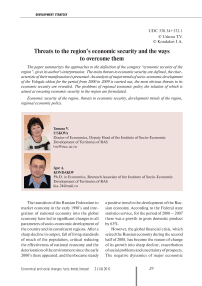Threats to the region's economic security and the ways to overcome them
Автор: Uskova Tamara Vitalevna, Kondakov Igor Anatolevich
Журнал: Economic and Social Changes: Facts, Trends, Forecast @volnc-esc-en
Рубрика: Development strategy
Статья в выпуске: 2 (14) т.4, 2011 года.
Бесплатный доступ
The paper summarizes the approaches to the definition of the category “economic security of the region”, gives its author's interpretation. The main threats to economic security are defined, the characteristic of their manifestation is presented. An analysis of major trends of socio-economic development of the Vologda oblast for the period from 2000 to 2009 is carried out, the most obvious threats to its economic security are revealed. The problems of regional economic policy the solution of which is aimed at ensuring economic security in the region are formulated.
Economic security of the region, threats to economic security, development trends of the region, regional economic policy
Короткий адрес: https://sciup.org/147223248
IDR: 147223248 | УДК: 330.34+332.1
Текст научной статьи Threats to the region's economic security and the ways to overcome them
The transition of the Russian Federation to market economy in the early 1990’s and integration of national economy into the global economy have led to significant changes in all parameters of socio-economic development of the country and its constituent regions. After a sharp decline in output, fall of living standards of much of the population, critical reducing the effectiveness of national economy and the deterioration of the environment since the early 2000’s there appeared, and then became steady a positive trend in the development of the Russian economy. According to the Federal state statistics service, for the period of 2000 – 2007 there was a growth in gross domestic product by 63%.
However, the global financial crisis, which seized the Russian economy during the second half of 2008, has become the reason of change of its growth into sharp decline, exacerbation of social problems and uncertainty of prospects. The negative dynamics of major economic indicators was observed in almost all regions of the country. Economic problems affected the wellbeing of the population: the index of consumer and social sentiment trended to be downward [8, 10, 24].
These circumstances require searching for ways to integrated solutions on economic, social and environmental problems and make the task of ensuring the economic security one of the most urgent.
Economic security issues do not lose their acuteness for the past several decades. Theoretical and methodological bases of studying this problem were founded in studies of domestic and foreign scientists, including L. Abalkin, A. Arkhipov, A. Gorodetsky, V. Ivanchenko, D. Lvov, A. Kuklin, P. Mina-kir, A. Mikhailenko, B. Mikhailov, A. Myzin, V. Tambovtsev, K. Samsonov, V. Senchagov, A. Skopin, A. Tatarkin etc.
Critical analysis of theoretical and methodological approaches to the definition of the category of “economic security” suggests that there are the following levels of economic security: international, national, regional, sectoral, microeconomic, and the level of families and individuals.
The regional level of economic security is one of the most important, as it is here where the goals and objectives of public policy in the sphere of security are realized. At the same time, solving the problem of economic security in the region one should take into account the criteria related to the state as a whole, and considering the specifics of economic security of the territory, separate organizations that operate in the region, and households.
In most studies the essence of “economic security of the region” is interpreted by analogy with the economic security of the national economy.
Thus, according to G.S. Vechkanov [9], the regions is a set of current state, conditions and factors that reflect stability, steadiness and sustainability of the country’s economic development [6].
From the standpoint of researchers N.S. Guskov, V.E. Zenyakin and V.V. Kryukov [11], the essence of economic security in the region can be defined as the possibility of effective control of regional authorities and the management of the efficient use of natural, human, material and financial resources, achieving economic growth, efficiency of regional production, improving the quality of products and services, demonopolization of production, competitive recovery of economic entities.
The author L.Yu. Falinsky [25] believes that the essence of economic security in the region lies in the ability and capacity of its economy to improve quality of life, to resist the influence of internal and external threats, to provide socio-economic and socio-political stability in the region.
Representatives of the Ural economic schools (A.I. Tatarkin, V.A. Chereshnev) [14, 23] suggest that the economic security of a territorial entity (oblast, republic, Federal district) is a set of conditions and factors that characterize the current state of the economy, stability, steadiness and sustainability of its development, the degree of its self-dependence in processes of integration with the economy of the Federation [10].
Critical analysis of the above definition suggests that they regard economic security as a static state of the region. In our view, this economic category should also reflect dynamic characteristics, i.e. the possibility of territory’s development in globalization and volatile external and internal environment.
In this regard, the economic security of the region is considered as a set of conditions and factors that characterize the stability of the economy, the steadiness and progressiveness of its development, the degree of independence and integration with national economy and the ability of regional authorities to create mechanisms for implementing and protecting the interests of economic entities, maintaining economic and social stability of the territorial community.
The reasons for the emergence and development of crisis situations, causing threats to the
Table 1. Characteristics of the main threats to economic security
|
Threat |
Characteristic |
|
Decline in production and loss (concession) of the internal market |
Destruction of technological capacity, folding progressive restructuring of the productive sector lead to extensive underloading of production capacity, switching separate productions and, consequently, loss of markets |
|
Destruction of scientific and technological capacity and deindustrialization of economy |
Cutting down of R&D, disintegration of research teams, reducing orders for high-tech products lead to degradation of scientific and technological capacity, the predominance of primary industries in the economic structure and, consequently, reducing territories’ competitiveness |
|
Loss of food self-sufficiency |
Aggravation of price distortions between industry and agriculture, full opening of domestic market to imported products with a reasonable rejection of paternalism in relation to the domestic manufacturer’s make the territories dependent on food supplies from other regions and countries |
|
Growth of unemployment and a weakening of labor motivation |
In view of the sharp decline in living standards and demand for highly skilled labor force there is loss of qualification and skills of the population |
|
Criminalization of economy |
Growth of economic crime and racketeering cause people’s disbelief in the ability to provide legal protection |
|
Environmental degradation |
Increase of technogenic loads and decrease of stability of the natural territorial complexes lead to an increase of diseases and forced-migration |
economic security, are the various external and internal factors. A region cannot have a direct impact on environmental factors, and therefore it must adapt to them. Internal environment factors are manageable, and influencing on them, you can manage the security of the regional socio-economic system.
The most significant threats to economic security, which appear due to the action of destabilizing factors, and their characteristics, are presented in table 1 .
The task of public authorities is monitoring of changes in the region and timely adjustment of the ongoing socio-economic policies. Any factor that has adverse effects on socio-economic processes and which was not settled or controlled in time, can create a threat to economic security.
Based on the foregoing, it follows that the economic security of the region is expressed by:
-
* the ability to implement its own economic policy within the federal center policy;
-
* the ability to conduct large-scale economic activities addressing the emerging socioeconomic issues;
-
* the ability to provide assistance to industries, business entities and socially vulnerable population groups in the region;
-
* the ability to provide the necessary level and quality of life in accordance with the accepted standards;
-
* the ability of authorities to respond to
changes in external and internal factors of development adequately.
Thus, in order to ensure economic security in the region the authorities’ activity should be directed to the following: first, to identify and classify the factors destabilizing the security and control over them; second, to identify threats; third, to develop and implement measures to overcome them.
The Vologda oblast is significantly affected by threats to economic security as it is an export-oriented, industrialized region in the North-West federal district.
Advantageous geographical location, proximity to the regions that are rich in fuel and mining resources, and to the areas with advanced manufacturing industry, good transportation services allow the oblast to establish effective business relationships with regions inside the country and foreign countries. It is conducive to economic development in the region.
However, the growth rate of the Vologda oblast is lower than the average in the Russian Federation. During the period from 2000 to 2007, the gross regional product grew by 38% while the national average – by 63% (fig. 1) . The most successful in terms of economic growth for the region was the year of 2004 when the GRP grew by 9.6%, then growth rates were significantly lower (4-5%). In 2009 as a result of the global financial crisis there was a signifi-
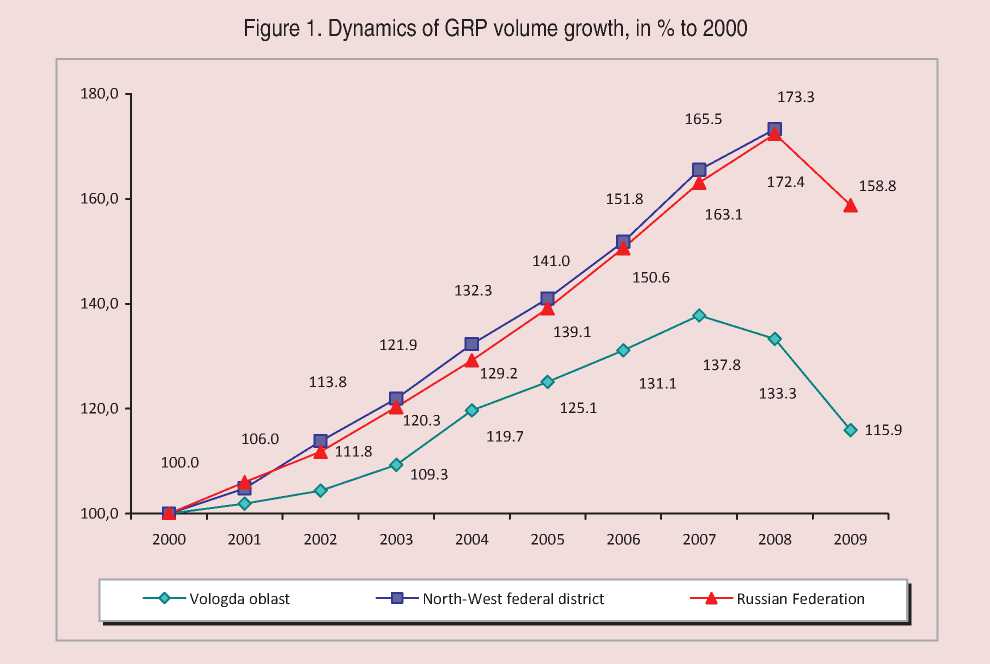
cant slowdown in volume of GRP growth in the region – by 13% to the previous year [13].
The Vologda oblast was 4th largest in the magnitude of the gross regional product per capita in 2008 among the subjects of NorthWest federal district (241.6 thousand rubles). [7]. However, in 2009 this figure dropped and amounted to 175 thousand rubles per person.
The role of productive sector (industry, agriculture, construction; fig. 2 ) is very significant in the creation of the gross regional product. The main share (about 40% of the total GRP) is in industry, and the socio-economic situation of the Vologda oblast mostly depends on the effectiveness of its functioning.
Export-oriented industries associated with the processing of raw materials – ferrous metallurgy and chemical production. In 2009, the share of these sectors in the region’s industry was 14 and 54% respectively [7]. Mono-structural character of industry and as a consequence, the dependence of the region’s development on the state of affairs of several large companies (JSC “Severstal” and a group of companies “FosAgro AG”) is a significant threat to the economy of the Vologda Oblast.
The Vologda oblast consistently has a trade surplus which is achieved through exports. Oblast’s foreign trade turnover per capita in 2009 compared with 2000 increased almost twice and amounted to 2.3 thousand dollars per capita, but this is below the national values (fig. 3) . As a result of impact of the crisis in 2009 there appeared a significant decline in foreign trade turnover (by 34% per capita). The oblast dropped to 6th place among the regions of NWFD, losing much of St. Petersburg, Leningrad and Kaliningrad oblasts [5].
Furthermore, it should be noted that in the export structure of the Vologda oblast the predominant are chemical industry and ferrous metallurgy (27 and 64% respectively). In the structure of imports, by contrast, a leading position is occupied by engineering products (67%) [7].
Raw materials export orientation , and, as a consequence, the dependence of prices on world markets is another significant threat to the region.
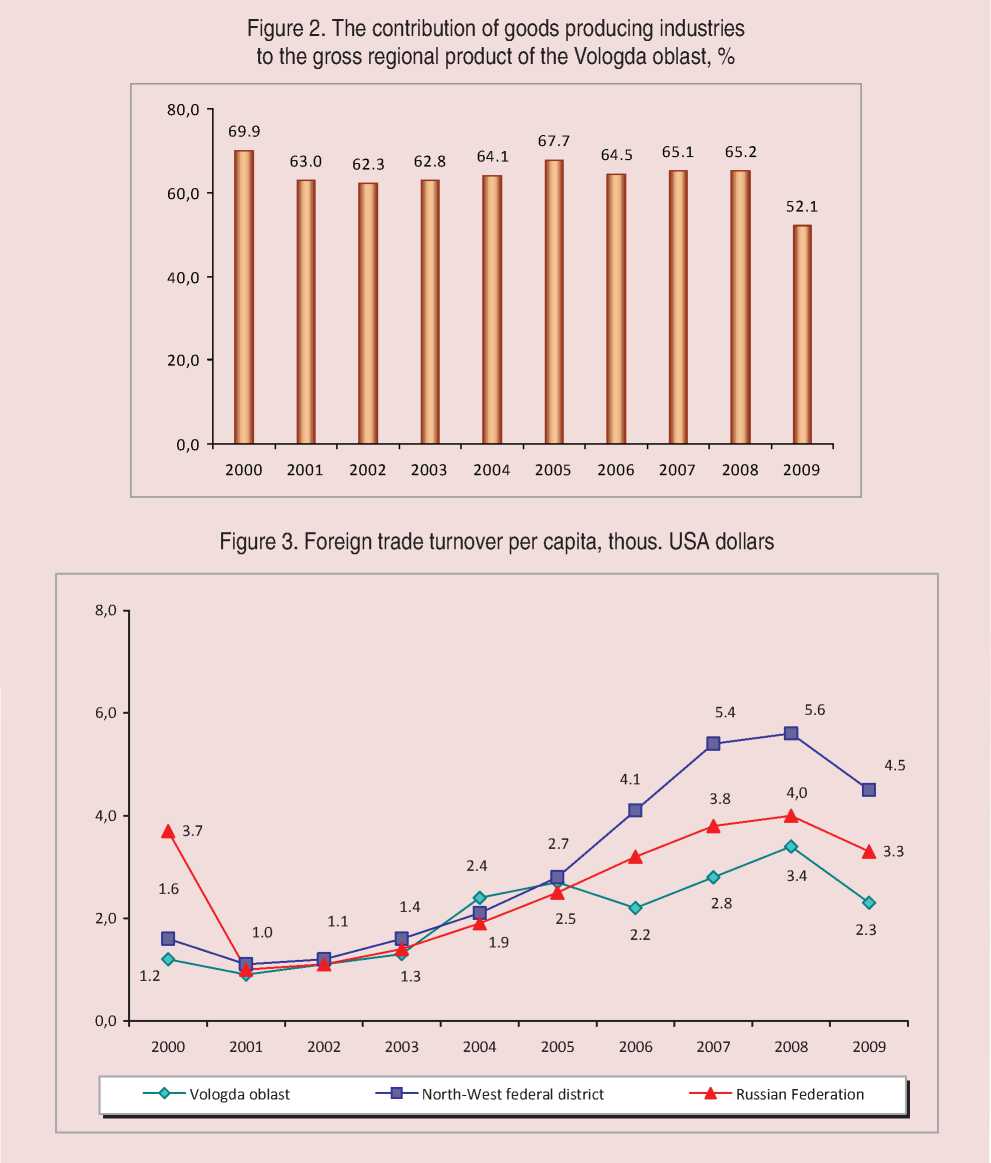
Narrow specialization of the Vologda oblast in conjunction with the weak performance of economic growth factors is inherent in the regions with the extensive type of economic growth, which on the one hand allows achieving high economic growth rates for short terms, but on the other it weakens the region’s resistance to various crisis processes. It was just confirmed by the global economic crisis which begun in autumn of 2008: the Vologda oblast was included in a list of 17 regions which suffered most.
The situation in the industrial sector in the region is still quite complicated. Since 2008,
Table 2. Production indices of the main types of economic activity, %
Type of economic activity 2010 to 2009 2009 to 2008 2010 to 2008 RF VО RF VО RF VО Mining operations 103.6 83.0 99.4 66.2 103.0 54.9 Electricity, gas and water production 104.1 108.2 96.1 89.2 100.0 96.3 Manufacturing activity 111.8 110.9 84.8 87.4 94.8 97.0 Including: metallurgical and complete metal products 112.4 116.0 81.9 87.0 95.9 99.9 machinery and equipment 112.2 124.1 71.9 68.7 76.9 85.1 chemical 114.6 103.0 91.5 105.8 106.7 109.7 timber processing and wood production 111.4 113.2 80.5 95.9 88.3 104.4 food 105.4 104.9 99.3 99.1 104.8 103.0 Sources: Socio-economic situation of the Vologda oblast in 2008: report / Vologdastat. – Vologda, 2008. – P. 14; Socio-economic situation of the Vologda oblast in January - November 2009: report / Vologdastat. - Vologda, November 2009. - P. 15; Data of the Federal state statistics service [Electronic resource]. – Available at:
Table 3. Net financial result of large and medium-sized businesses per capita, thous. rubles (in prices 2009)
Among manufacturing industries the most significant growth in 2010 occurred in chemistry (15%) and metallurgy (13%), machinery and wood processing (12%) which are basic in regional specialization. However, indicators growth rates do not provide bringing up to the level of 2008.
The financial results of the Vologda oblast enterprises are indicative of difficult economic environment. As a result of the crisis impact in 2009, their profits in current prices fell almost 4 times and amounted to 20.8 thousand rubles per capita (tab. 3) .
Reduction of enterprises’ own funds affected the amounts of their investments in production. After steady growth since 2007 there has been a significant reduction in this indicator (by 29%). In 2009 it was 45.7 thousand rubles per capita, while the average for the North-West federal district and the Russian Federation it was 67.8 and 55.9 thousand rubles respectively (fig. 4) . This situation negatively affects the process of economic modernization in the region.
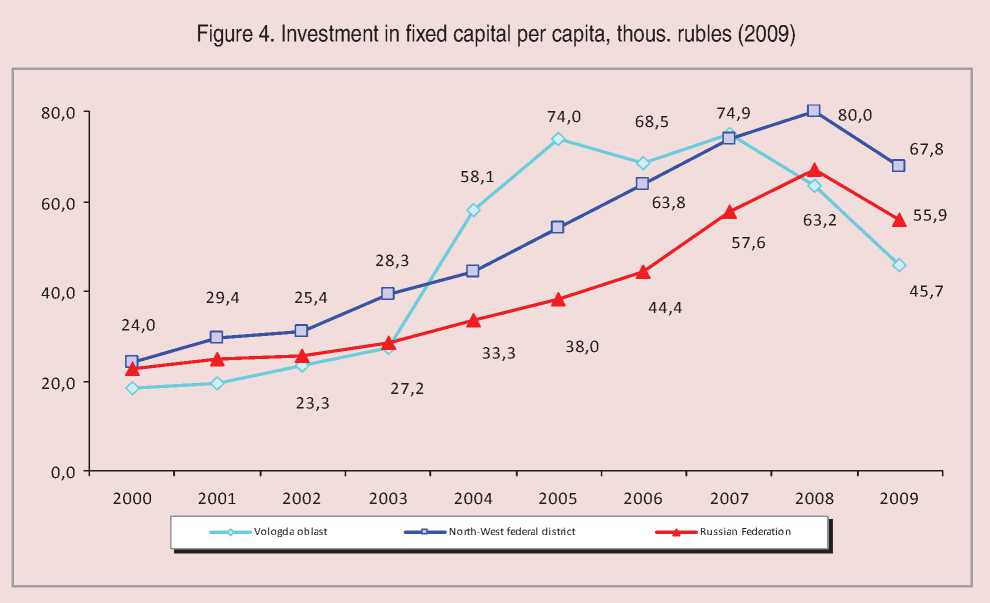
Figure 4. Investment in fixed capital per capita, thous. rubles (2009)
|
80,0 |
58,1 |
74,0 |
68,5 |
74,9 |
80,0 |
67,8 |
|||||
|
60,0 |
63,8 |
63,2 |
55,9 |
||||||||
|
28,3 |
57,6 |
||||||||||
|
40,0 |
24,0 |
29,4 |
25,4 |
44,4 |
45,7 |
||||||
|
33,3 |
38,0 |
||||||||||
|
20,0 |
27,2 |
||||||||||
|
о— |
23,3 |
||||||||||
|
0,0 |
• |
• |
|||||||||
|
2000 |
2001 |
2002 |
2003 |
2004 |
2005 |
2006 |
2007 |
2008 |
2009 |
||
|
Vologda oblast |
|||||||||||
Table 4. Execution of the regional budget per capita, thous. rubles (in prices 2009)
|
Territory |
2000 |
2001 |
2002 |
2003 |
2004 |
2005 |
2006 |
2007 |
2008 |
2009 |
2009 to 2000, times |
|
St. Petersburg |
24.0 |
27.9 |
31.5 |
32.8 |
36.0 |
48.4 |
67.3 |
76.5 |
81.3 |
69.8 |
2.9 |
|
Murmansk oblast |
23.7 |
22.2 |
27.0 |
26.8 |
31.9 |
30.7 |
48.3 |
60.3 |
61.8 |
55.0 |
2.3 |
|
Komi Republic |
30.1 |
31.3 |
33.0 |
30.4 |
34.7 |
38.0 |
42.7 |
43.6 |
49.7 |
47.3 |
1.6 |
|
Kaliningrad oblast |
13.3 |
13.6 |
17.8 |
18.2 |
19.7 |
24.0 |
30.7 |
36.7 |
42.9 |
44.9 |
3.4 |
|
Arkhangelsk oblast |
14.1 |
18.0 |
19.9 |
21.8 |
23.4 |
26.5 |
30.1 |
38.2 |
44.3 |
39.0 |
2.8 |
|
Leningrad oblast |
18.8 |
22.0 |
26.0 |
27.2 |
29.0 |
31.8 |
45.8 |
37.6 |
42.7 |
38.2 |
2.0 |
|
Republic of Karelia |
23.9 |
23.8 |
28.9 |
26.7 |
33.1 |
39.2 |
40.7 |
36.2 |
43.2 |
37.5 |
1.6 |
|
Novgorod oblast |
13.7 |
14.5 |
15.0 |
16.5 |
18.6 |
25.4 |
25.2 |
28.0 |
36.5 |
36.6 |
2.7 |
|
Vologda Oblast |
20.5 |
19.9 |
21.9 |
25.1 |
33.6 |
32.3 |
36.7 |
42.6 |
44.7 |
32.9 |
1.6 |
|
Pskov oblast |
11.3 |
13.7 |
17.6 |
17.3 |
17.4 |
18.8 |
21.5 |
25.0 |
28.2 |
28.5 |
2.5 |
|
NWFD |
16.1 |
23.0 |
22.7 |
23.6 |
28.5 |
32.1 |
37.2 |
41.8 |
47.4 |
50.8 |
3.2 |
|
RF |
20.8 |
21.8 |
23.6 |
25.0 |
28.0 |
31.6 |
36.8 |
42.0 |
47.5 |
41.8 |
2.0 |
|
Source: Regions of Russia. Socio-economic indicators: 2010 stat. coll. / Rosstat. – M.: 2010. – Pp. 826-851. |
|||||||||||
The reduction of budgetary provision also indicates of the increased threat to economic security of the Vologda oblast. The crisis that influenced the industry has undermined one of the main sources of the budget - tax on profits. The volume of this tax fell by more than 20%, and the oblast dropped in terms of fiscal capacity to 9th place among the regions of the NWFD (tab. 4) . Since 2011 the Vologda oblast has become subsidized.
Decline in living standards of the population should be also considered as a threat to economic security. In general, for the period from 2000 to 2009 in the Vologda oblast, average per capita income has grown 6 times and amounted to only 12.1 thousand rubles per month, although it is considerably lower than in the NWFD and the country as a whole (17.0 and 16.9 thousand rubles, respectively, tab. 5 ). Such a level of per capita income reduces the
Table 5. Per capita income of the population per month, thous. rubles (in prices 2009)
|
Territory |
2000 |
2001 |
2002 |
2003 |
2004 |
2005 |
2006 |
2007 |
2008 |
2009 |
2009 to 2000, times |
|
St. Petersburg |
7.59 |
8.61 |
9.87 |
13.36 |
15.89 |
19.41 |
19.88 |
20.95 |
19.22 |
21.33 |
2.8 |
|
Murmansk oblast |
11.53 |
12.24 |
12.74 |
13.54 |
14.35 |
16.02 |
17.86 |
19.21 |
20.76 |
21.00 |
1.8 |
|
Komi Republic |
9.56 |
12.28 |
13.80 |
14.04 |
15.73 |
17.18 |
18.63 |
20.05 |
20.24 |
19.99 |
2.1 |
|
Arkhangelsk oblast |
6.30 |
7.49 |
8.40 |
9.09 |
10.24 |
11.99 |
13.35 |
14.34 |
16.09 |
16.56 |
2.6 |
|
Kaliningrad oblast |
5.32 |
5.59 |
5.92 |
7.06 |
7.78 |
9.64 |
12.30 |
14.18 |
13.93 |
14.50 |
2.7 |
|
Republic of Karelia |
6.65 |
7.13 |
8.57 |
9.24 |
9.78 |
10.86 |
12.34 |
12.52 |
13.45 |
13.51 |
2.0 |
|
Novgorod oblast |
5.29 |
6.03 |
6.53 |
7.06 |
7.32 |
8.34 |
9.94 |
10.63 |
12.62 |
13.07 |
2.5 |
|
Leningrad oblast |
4.23 |
4.90 |
5.52 |
6.16 |
7.83 |
9.11 |
11.83 |
13.35 |
13.22 |
12.14 |
2.9 |
|
Vologda oblast |
5.60 |
6.53 |
7.39 |
8.27 |
8.81 |
9.56 |
11.97 |
12.87 |
13.07 |
12.06 |
2.2 |
|
Pskov oblast |
3.78 |
4.31 |
5.67 |
6.53 |
7.06 |
7.31 |
8.78 |
9.62 |
11.10 |
11.21 |
3.0 |
|
NWFD |
6.64 |
7.62 |
8.65 |
10.29 |
11.78 |
13.81 |
15.29 |
16.44 |
16.37 |
17.03 |
2.6 |
|
RF |
6.49 |
7.35 |
8.24 |
9.63 |
10.69 |
12.19 |
14.07 |
15.53 |
16.25 |
16.89 |
2.6 |
|
Source: Regions of Russia. Socio-economic indicators: 2010 stat. coll. / Rosstat. – M.: 2010. – P. 164. |
|||||||||||
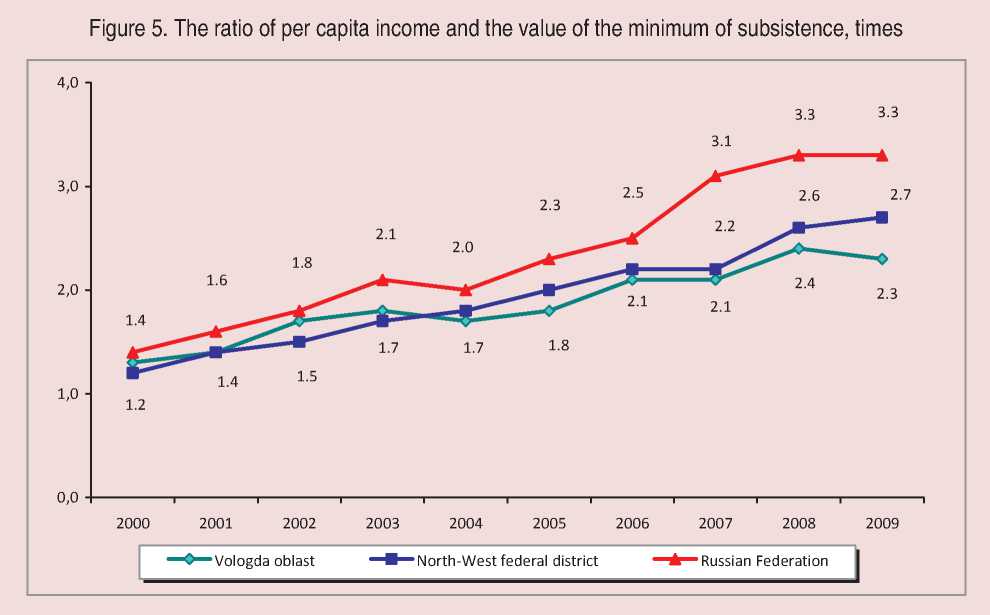
solvent population demand, and without it, it is impossible to increase production of goods and services.
Low level of per capita income in the Vologda oblast is also confirmed by its relation to the value of the minimum of subsistence (the valuation of a minimum set of food, non-food goods and services necessary to maintain per- son’s health and to ensure his/her life activity). In 2009 per capita incomes in the region exceeded the subsistence minimum 2.3 times, while in the North-West federal district and Russia, this ratio reached 2.7 and 3.3 times, respectively (fig. 5).
And at that16% of the region’s inhabitants had incomes that were not even enough to buy
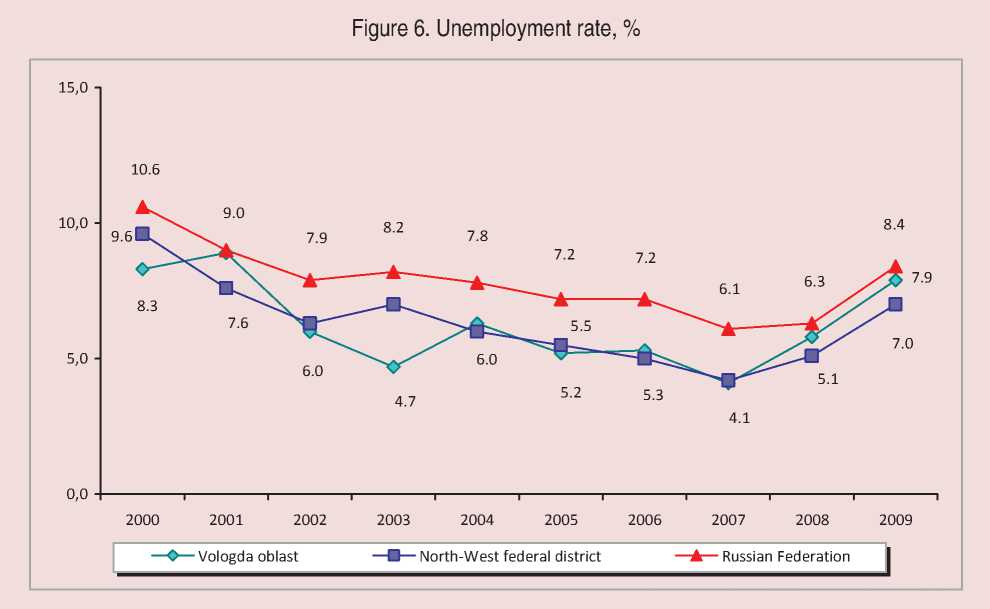
a minimum basket of goods (13%in Russia as a whole) [5]. Public opinion polls show that the situation in the region is even more difficult. In the structure of social self-identification of the population the group of “the poor and needy” is the most numerous (47-49%)1.
Unemployment increase is also a factor destabilizing the social situation in the region. If before 2008 the unemployment rate in the Vologda oblast was one of the lowest in the North-West federal district, as a consequence of the global financial crisis there has been a significant increase in this index in the region – up to 7.9% (average for Russia – 8.4%, fig. 6 ). An unemployed person, who has no source of income, can only count on the state’s support in the form of a benefit, the value of which ranges from 978 to 5 635 rubles with regard to 15% of the northern coefficient [12].
Falling living standards and the difficult economic situation do not favor the reduction of the population morbidity. According to this index the Vologda oblast is at 6th place in the district. And for each one thousand population there are 887 of ill people per year, whereas in the Leningrad oblast there are only 585 people (1st place). There was a significant reduction in morbidity in 2003 – 2005 compared with the year of 2000 (tab. 6).
In general, the morbidity rate in the region is still quite high .
The present demographic situation both in the Vologda oblast, and in the Russian Federation as a whole is characterized by a persistent population decline that began in 1992 (tab. 7) . According to the forecast of ISEDT RAS, by the beginning of 2020 the working age population in the Vologda oblast will decrease by 18%. In other words, the aging of the population in the region will continue in the period until 2020, the consequences of which will be significant for the demographic (“base” for low fertility and high mortality rates), economic (slowdown in the process of labor substitution, increase of load on the working-age population) and social (welfare spending increase, load on social infrastructure increase) aspects of social life [26].
Table 6. Morbidity per 1 thousand of the population, people
|
Territory |
2000 |
2001 |
2002 |
2003 |
2004 |
2005 |
2006 |
2007 |
2008 |
2009 |
2009 to 2000, % |
|
Leningrad oblast |
543 |
546 |
538 |
548 |
524 |
529 |
541 |
524 |
517 |
585 |
107.7 |
|
Pskov oblast |
617 |
601 |
620 |
629 |
606 |
593 |
610 |
621 |
645 |
803 |
130.1 |
|
Kaliningrad oblast. |
598 |
605 |
626 |
640 |
668 |
700 |
747 |
735 |
749 |
821 |
137.2 |
|
Novgorod oblast |
796 |
811 |
809 |
863 |
817 |
835 |
894 |
856 |
817 |
905 |
113.7 |
|
Murmansk oblast |
870 |
873 |
838 |
826 |
817 |
780 |
815 |
818 |
821 |
855 |
98.2 |
|
Vologda oblast |
850 |
836 |
826 |
810 |
808 |
803 |
869 |
836 |
866 |
887 |
104.3 |
|
St. Petersburg |
694 |
663 |
678 |
688 |
682 |
742 |
801 |
825 |
873 |
916 |
132.0 |
|
Komi Republic |
1092 |
1008 |
1063 |
1043 |
984 |
943 |
940 |
956 |
938 |
983 |
90.0 |
|
Arkhangelsk oblast |
915 |
918 |
926 |
930 |
930 |
921 |
985 |
967 |
957 |
1023 |
111.8 |
|
Republic of Karelia |
1002 |
1006 |
1027 |
1083 |
1057 |
1001 |
1009 |
983 |
1012 |
1052 |
105.0 |
|
NWFD |
798 |
787 |
795 |
806 |
789 |
785 |
821 |
812 |
820 |
878 |
110.0 |
|
RF |
730 |
719 |
740 |
748 |
744 |
745 |
765 |
771 |
857 |
803 |
110.0 |
|
Source: Regions of Russia. Socio-economic indicators: 2010 stat. coll. / Rosstat. – M., 2010. – P. 322. |
|||||||||||
Table 7. Population size, thousand people
|
Territory |
1992 |
2000 |
2000 to 1992, % |
2009 |
2009 to 2000, % |
2009 to 1992, % |
|
St. Petersburg |
4986 |
4715 |
94.6 |
4582 |
97.2 |
91.9 |
|
Leningrad oblast |
1678 |
1680 |
100.1 |
1632 |
97.1 |
97.3 |
|
Arkhangelsk oblast |
1554 |
1369 |
88.1 |
1262 |
92.2 |
81.2 |
|
Vologda oblast |
1353 |
1290 |
95.3 |
1218 |
94.4 |
90.0 |
|
Komi Republic |
1222 |
1043 |
85.4 |
959 |
91.9 |
78.5 |
|
Kaliningrad oblast |
898 |
958 |
106.7 |
937 |
97.8 |
104.3 |
|
Murmansk oblast |
1170 |
923 |
78.9 |
843 |
91.3 |
72.1 |
|
Pskov oblast |
837 |
782 |
93.4 |
696 |
89.0 |
83.2 |
|
Republic of Karelia |
789 |
729 |
92.4 |
687 |
94.2 |
87.1 |
|
Novgorod oblast |
748 |
710 |
94.9 |
646 |
91.0 |
86.4 |
|
NWFD |
15259 |
14199 |
93.1 |
13462 |
94.8 |
88.2 |
|
RF |
148326 |
146304 |
98.6 |
141914 |
97.0 |
95.7 |
|
Source: Regions of Russia. Socio-economic indicators: 2010 stat. coll. / Rosstat. – M.: 2010. – P. 56. |
||||||
Natural decline in the region’s population is not compensated by the migration movement. Since 2001, the value index of net migration in the Vologda oblast remains extremely low (fig. 7 ): in 2009 the level of migration was only 0.5 people per 10 thousand of the population. For comparison: in Russia as a whole (international migration) and the North-West federal district migration rates coefficients are ten times greater (17 and 21 people per 10 thousand population, respectively). In the European Union in 2008 this figure was 29 people per 10 thousand of the population [6]. The presented facts indicate a low spatial mobility of Vologda inhabitants.
Besides those mentioned above, a threat to economic security in the region is a complex environmental situation in the cities of the Vologda oblast due to the fact that a significant share in the economic structure is occupied with industries related to mining and processing of raw materials.
As you known, the main air pollutants are the enterprises of ferrous metallurgy, chemical and petrochemical industry, construction industry, energy, and pulp and paper industry [18]. The most complex is currently the environmental situation in Cherepovets. Studies of air quality have shown that in the industrial district of contamination above the maximum
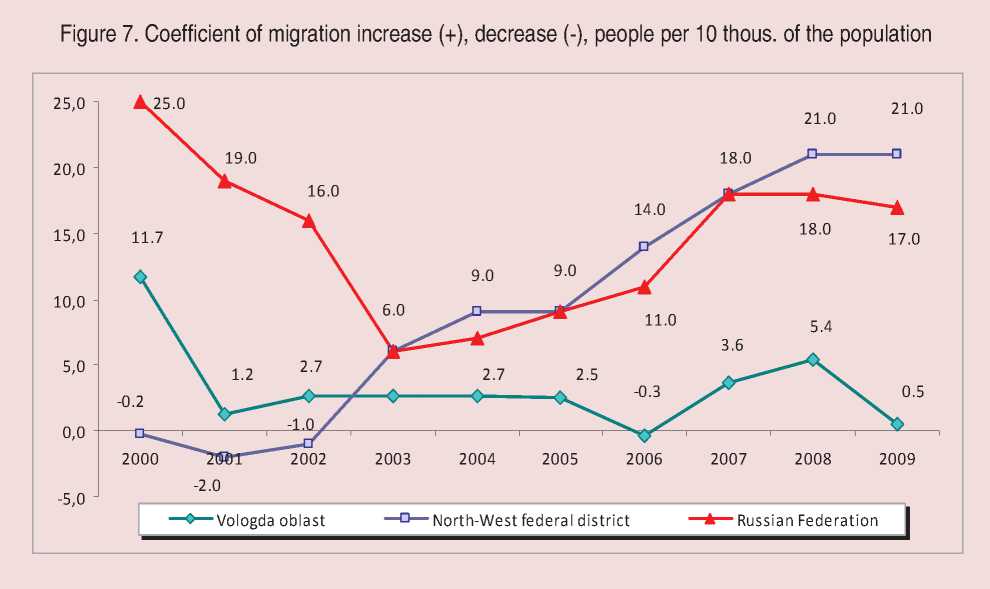
allowable daily concentrations of nitrogen dioxide – to 1.3 times, carbon disulfide – 2.4 times, formaldehyde – 3.3 times, carbon monoxide – to 1.3 times [19].
Drinking water quality does not meet sanitary requirements because of the poor water treatment, poor public water supply system and severe pollution of water sources (the problem is especially urgent in urban areas). Some contribution to this process is made by agroindustrial complex: in agricultural production there is no adequate treatment of wastewater discharged into rivers, mineral fertilizers often excess the standards, and toxic chemicals are stored in open areas. The state lands and forests on the territory of the Vologda oblast continues to worsen [24].
Analysis of major trends in the socio-economic development allowed distinguishing the following most important threats to the economic security of the Vologda oblast:
-
a) single-industry structure of the economy and high dependence on chemical and metallurgical production, which implies the predominance of raw material orientation of the region and reducing its competitiveness;
-
b) reduction of the volume and rates of production growth in connection with the consequences of the global financial crisis, which leads to underloading of the existing facilities, effectiveness decline and closure of individual businesses and, consequently, an increase in unemployment;
-
c) the predominance of commodity exports in contrast to the export of high-tech products, which leads to a reduction in budget revenue and possibility to update the machines and equipment;
-
d) full opening of the domestic market for imported products at a rejection of reasonable paternalism in relation to domestic producers, which leads to the region’s dependence on supplies from other countries, the destruction of production;
-
e) an increase in anthropogenic loads and decrease in stability of the environment which leads to an increase in morbidity and forced migration of population to other, more prosperous regions and countries;
-
f) reduction in population size and level of its money income, which leads to deterioration of the quality characteristics of region’s the employment potential.
The Vologda oblast Government is implementing a strategy (up to the year of 2020) and a program of the region’s social and economic development for the years of 2011 – 2013 developed on its basis. [1, 2], aimed at creating conditions for improving the competitiveness of regional economies, improving quality of population’s life, improving the efficiency of public administration system.
The identified threats require revitalization of the regional state authorities’ activity, improvement of the ongoing socio-economic policy, formulation and implementation of measures aimed at improving the region’s economic security.
In general, there can be the following objectives of regional economic policies, aimed at ensuring economic security:
-
> restructuring of the economy, supporting the most profitable and promising sectors and industries having advantages in the long run;
-
> creation of territorial production complexes, which are market oriented and responsive to the market change;
-
> implementation or activation of own sources of development;
-
> development of inter-regional infrastructure systems with a worthy representation of the region;
-
> containment and elimination ofthe depressive state of some areas, and if necessary giving them the status of “areas of economic distress”.
In addition to that they need to be specified taking into account the specific character of the regions and the threats to economic security. However, these are the tasks for another article.
Список литературы Threats to the region's economic security and the ways to overcome them
- Law of the Vologda oblast dated 08.12.2010, № 2428-OL "On approval of the Programme of socio-economic development of the Vologda oblast in 2011 -2013"//The newspaper "Krasny Sever". -2010. -№ 139.
- Resolution of the Government of the Vologda oblast dated 28.06.2010, № 739 "On the Strategy of socio-economic development of the Vologda dated for the period up to 2020"//The newspaper "Krasny Sever". -2010. -№ 89, 92, 95.
- Presidential Decree from 12.05.2009, № 537 "On the Strategy of the national security of the Russian Federation to 2020"//Rossiyskaya Gazeta. -2009. -№ 88.
- Regions of Russia. Socio-economic indicators. 2010: stat. sat/Rosstat. -M., 2010. -996 p.
- Regions of the North-West federal district. Socio-economic indicators. 2010: stat. coll./Vologdastat. -Vologda, 2010. -225 p.
- Russia and the countries -members of the European Union. 2009.: stat. coll./Rosstat. -M., 2009. -259 p.
- Statistical Yearbook of the Vologda oblast. 2008: stat. coll./Vologdastat. -Vologda, 2009. -399 p.
- Aksenov, V.S. The global financial crisis and economic security of Russia: analysis, challenges and prospects/V.S. Aksenov, M.I. Gelvanovsky, Yu.N. Nesterenko. -M.: Economika, 2010. -205 p.
- Vechkanov, G.S. Economic security: a textbook for high schools/G.S. Vechkanov. -SPb.: Peter, 2007. -384 p.
- President of Russia D.A. Medvedev at the World Economic Forum in Davos on 26.01.2011 . -Available at: http://prezident.rf/
- Gus'kov, N.S. Economic security of Russia's regions/N.S. Gus'kov, V.E. Zenyakin, V.V. Krukov. -M.: Algorithm, 2000. -287 p.
- Data of the Vologda oblast Employment Department . -Available at: http://www.depzan.info/
- Volume indices of gross regional product in 1998 -2008. . -Available at: http://www.gks.ru/free_doc/new_site/vvp/din98-08.xls
- Life quality and economic security of Russia/ed. by V.A. Chereshneva, A.I. Tatarkina. -Ekaterinburg: Institute of Economics UD RAS, 2009. -1184 p.
- Kuznetsova, E.I. Development of competitive relations, and the state's economic strategy: monograph/E.I. Kuznetsova. -M.: UNITY-DANA, 2008. -383 p.
- Luzin, G.P. Stability and economic security in the regions: trends, criteria, regulatory mechanism/G.P. Luzin, V.S. Selin, A.V. Istomin, S.Yu. Koz'menko. -Apatity: KSC RAS, 1999. -174 p.
- Modernization and economic security of Russia/ed. by N.Ya. Petrakova. -M.: Finance and credit, 2009. -568 p.
- Rumina, E.V. Environmentally-adjusted estimate of regional economic development/E.V. Rumina, A.M. Anikin//The journal “Problemy prognozirovaniya”. -2009. -№ 2. -Pp. 78-94.
- St. Petersburg, Arkhangelsk and Cherepovets -the dirtiest cities of North-West . -Available at: http://www.ecoindustry.ru/news.html&id=9495
- Socio-economic situation of the Vologda oblast in 2008: report/Vologdastat. -Vologda, 2008. -152 p.
- Socio-economic situation of the Vologda oblast in 2009: report/Vologdastat. -Vologda, 2009. -166 p.
- Socio-economic situation of the Vologda oblast in 2010: report/Vologdastat. -Vologda, 2010. -166 p.
- Socio-economic risks: causes diagnostics and forecast scenarios for neutralization/ed. by V.A. Chereshnev, A.I. Tatarkin. -Ekaterinburg: Institute of Economics UD RAS, 2010. -1200 p.
- Uskova, T.V. Managing sustainable development in the region: monograph/T.V. Uskova. -Vologda: ISEDT RAS, 2009. -355 p.
- Falinsky, L.Yu. Shadow economy as a threat to economic security of the region (on the example of the Southern federal district of the Russian Federation): abstract of Ph.D. theses in Economics: 08.00.05/L.Yu. Falinsky. -M., 2009. -30 p.
- Shabunova, A.A. The Vologda oblast: prospects for demographic development of the territories: preprint/A.A. Shabunova, A.O. Bogatyrev. -Vologda: ISEDT RAS, 2010. -28 p.

